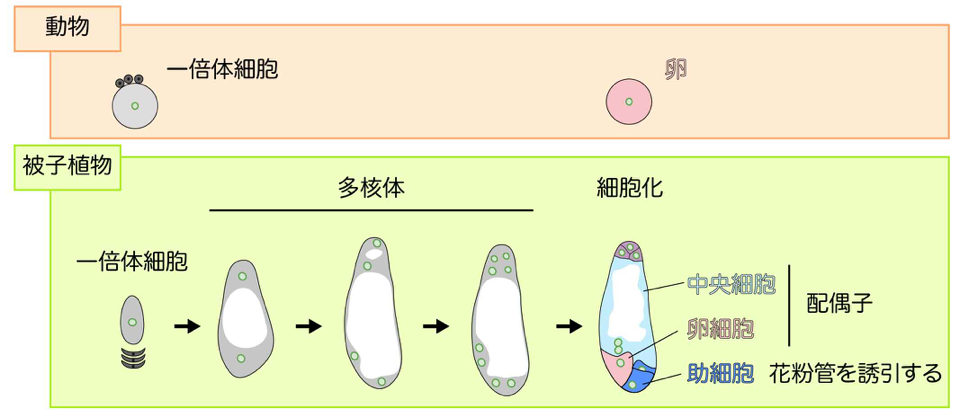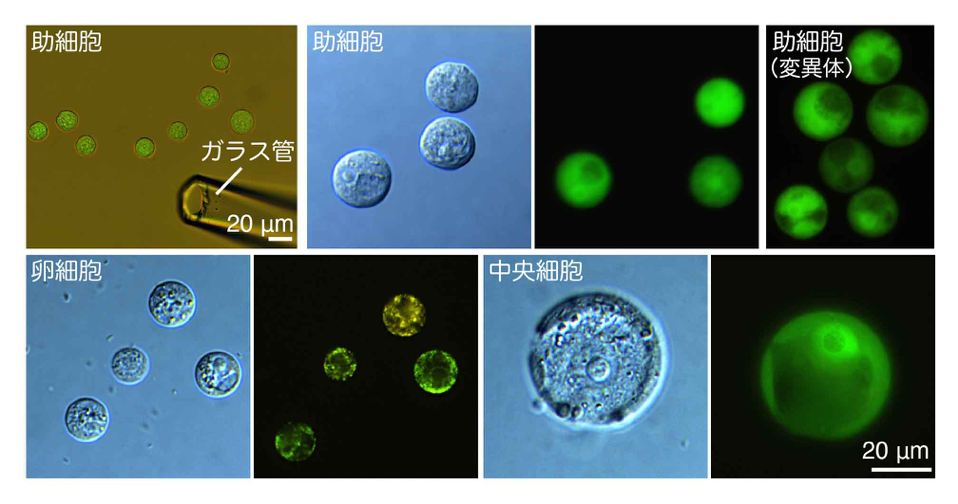Research Highlights
Dynamics of the cell fate specifications during female gametophyte development in Arabidopsis
The Nagoya University Institute of Transformative Bio-Molecules (WPI-ITbM) research group of JST PRESTO Designated Lecturer Daisuke Kurihara and Professor Tetsuya Higashiyama, working with a team including Yokohama City University Kihara Institute for Biological Research JSPS Research Fellow Daichi Susaki and Chubu University College of Bioscience and Biotechnology Designated Professor Takamasa Suzuki, have developed a system which allows the live imaging of the creation of the female gamete in plants.
In flowering plants, the sperm cell and egg cell meet and fertilization takes place in the flower. While sperm cells are made in the pollen, egg cells are made in the ovule, the structure that becomes the seed. However, as the ovule is buried deep within the pistil, it has thus far been impossible to observe the formation of the egg cell in living plants.
The research team, using an ovule culturing technology that they had developed previously, succeeded in capturing images of the egg cell being created inside the ovule. On top of that, they were able to isolate the egg cell and its adjoining cells, and by analyzing the genes expressed in these few cells, elucidate how the cells adjoining the egg cell determine its fate.
It is expected that the success of this research will contribute to revealing the whole process of egg cell production and fertilization, and help develop methods of breeding and cultivating plants.
This study is published in the online edition of the American science journal PLoS Biology on 27 March 2021.
About the research
Living things which carry out sexual reproduction produce offspring via a fertilization process involving male and female gametes. In animals, the female gamete (the egg) is produced from haploid cells by meiosis. In the majority of flowering plants, following meiosis, karyomitosis (nuclear division) then takes place three more times within the cell, and it continues its development as an apocyte. Following this, the cell divides, producing cells with a variety of different roles including two gametes, the egg cell and central cell, and the auxiliary cells, which attract the pollen tube (Figure 1). However, it was not yet understood precisely how the two female gametes were produced among the 7 new cells that result from this division. Although it is thought that the position of the nuclei within the cell is important in determining cell fate, as the gametes form in the ovule, deep within the flower, it has been impossible to observe the full process in real time. The research group, using Torenia, a genus of plants whose gametes had already partially been revealed, had succeeded in observing part of the gamete development process, but were unable to capture the entire thing.

Figure 1: formation of the female gamete in animals and plants
In the majority of flowering plants, karyomitosis takes place three times, forming an apocyte. Once there are 8 nuclei, plasma membranes form, creating individual cells including the egg cell, central cell and auxiliary cells.
Previously, the research group had succeeded in removing the ovules from the pistils of Arabidopsis thaliana, separating the fertilized eggs from inside them and subsequently reproducing embryogenesis. This time, using this ovule culturing method, they were able to observe, in real time, the creation of the female gamete in Arabidopsis thaliana. They saw that the nucleus produced by meiosis separated, with the resulting two nuclei going to the opposite poles of the cell. Dividing again into four, the nuclei lined up along the edge of the cell. Finally, having divided again into eight, the plasma membranes were constructed around the nuclei, demonstrating the formation of the cells which are attached to the two gamete cells (the egg cell and the central cell). Having observed 157 cases of this division, they found that the nuclei close to where the pollen tube penetrates would become the nuclei of the auxiliary, egg and central cells, demonstrating that the position of the nuclei within the cell has a strong correlation with cell fate.

Figure 2: Live imaging of the formation of the gamete
Nuclei are shown in green, plasma membranes in pink, and the arrows indicate the nuclei of the gametophyte. The imaging begins in the two nuclei phase (0:00), proceeding through the four- and eight-nuclei phases (5:50-11:10), and finally into the formation of the egg, central and auxiliary cells (11:45-20:45). Numbers denote hours and minutes passed since the start of observation.
Continuing, in order to find out when the various cells' fates are determined, they analyzed the time at which expression of the specific transcription factor myb98, important for the differentiation and function of the auxiliary cells, commenced. They found that myb98 begins to be expressed very shortly after the nuclei divide into 8 and are enclosed by the plasma membranes. Given that the specific transcription factor for the egg cell can also be found in the egg cell at the same early stage, it can be considered that cell fate is determined immediately after the formation of the plasma membranes, or possible even earlier.
On top of this, the group discovered that in a myb98 mutant variant, the nuclear dynamics of the auxiliary cells were unstable, and the cells were swollen. To find out what effect this change in nuclear dynamics has on cell fate, they separated the gametes and auxiliary cells and carried out a gene expression analysis. As these few cells are buried deep in the ovule, they have to be carefully removed in order for their gene expression to be analyzed. Having done so, the group separated the gametes and auxiliary cells under a microscope, set up an experiment for analyzing the genetic information of each cell, and elucidated the specific genes present in each cell.

Figure 3: Isolation of gamete and auxiliary cells in Arabidopsis thaliana
The gamete and auxiliary cells are isolated from the ovule. The individual cells are marked with a fluorescent protein under a microscope and their gene expression investigated.
Upon comparing the gene expression of the myb98 mutant variant to that of a wild plant, they were surprised to find that a large number of egg cell specific genes were highly expressed in the variant's auxiliary cells. They observed the expression of one of these, the egg cell specific protein SBT4.13, in real time in the myb98 variant, and found that, following the formation of the plasma membrane and expression of SBT4.13 in the egg cell, ectopic expression of SBT4.13 followed comparatively quickly in the auxiliary cells (Figure 4)

Figure 4: Expression of egg cell specific protein in auxiliary cells in the variant plant
Upon analysis of the variant, it was found that the egg cell specific protein SBT4.13 was expressed not only in the egg cell, but also in the auxiliary cells shortly after. Numbers denote hours and minutes passed since the start of observation.
This study has demonstrated how plants ensure the survival of important cells such as gametes by retaining the ability to flexibly change cell fate, crucial for their adaptability as immobile organisms to the changing environment around them. Going forward, the focus will be on discovering how the cell fate change is accomplished, and elucidating its molecular mechanism. Once the molecular mechanism has been analyzed, it is hoped that research will contribute to the development of methods to increase plant fertilization rates.
Additionally, while it has now been determined that cell fate is decided at a relatively early stage, how the positions of the nuclei in polykaryotic cells affects cell fate remains unclear. It is expected that by utilizing the real time imaging, cell isolation and low cell number gene expression analysis techniques established in this study, worldwide plant gamete research will be accelerated.
Vocabulary
1) Gamete
Cells involved in fertilization and birth of offspring. In plants, the spermatid and egg cell. In animals, the sperm and egg.
2) Gametophyte
Structure in plants which makes the gametes for reproduction. Haploid generation, also known as the embryo sac in females.
3) Apocyte
A cell with multiple nuclei. Although cells usually have just one nucleus, an apocyte allows for cell division without nuclear division, thus allowing for the created of multiple cells with single nuclei.
4) Ovule
Buried deep within the pistil, the ovule is the structure that will become the seed. The fertilized egg cell is produced by the fertilization of the egg cell contained within the ovule by the spermatid transported by the pollen tubes. The fertilized egg then divides, a process known as embryogenesis.
5) Cell fate
The 'fate' of a cell is the determination of the kind of cell which it will differentiate into following division.
Journal information
The article 'Dynamics of the cell fate specifications during female gametophyte development in Arabidopsis' by Daichi Susaki, Takamasa Suzuki, Daisuke Maruyama, Minako Ueda, Tetsuya Higashiyama and Daisuke Kurihara is published in PLoS Biology.
DOI: 10.1371/journal.pbio.3001123
2021-03-29

